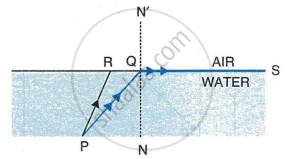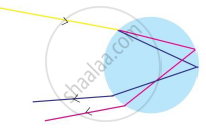Advertisements
Advertisements
प्रश्न
A ray of light incident at an angle of incidence ‘i’ passes through an equilateral glass prism such that the refracted ray inside the prism is parallel to its base and emerges from the prism at an angle of emergence ‘e’.
How is the angle of emergence ‘e’ related to the angle of incidence ‘i’?
उत्तर
Angle of emergence = angle of incidence.
APPEARS IN
संबंधित प्रश्न
In the given figure PQ and PR are the two light rays emerging from an object P. The ray PQ is refracted as QS.

- State the special name given to the angle of incidence ∠PQN of the ray PQ.
- What is the angle of refraction for the refracted ray QS?
- Name the phenomenon that occurs if the angle of incidence ∠PQN is increased.
- The ray PR suffers partial reflection and refraction on the water-air surface. Give reason.
- Draw in the diagram the refracted ray for the incident ray PR and hence show the position of image of the object P by the letter P’ when seen vertically from above.
i) Observe the given figure and answer the following questions.
a) Identify and write the natural process shown in the figure.
b) List the phenomena which are observe in this process.
c) Redraw the diagram and show above phenomena in it.

Plot a graph between
Angle of incidence versus angle of reflection,
How are critical angles related to the refractive index of the medium?
State two advantages of using a right-angle prism as a reflector, rather than a plane mirror.
Answer the following question.
Define the critical angle of incidence and obtain an expression for it.
Solve Numerical example.
From the given data set, determine angular dispersion by the prism and dispersive power of its material for extreme colours. nR = 1.62 nV = 1.66, δR = 3.1°
Critical angle of light passing from glass to air is maximum for ____________.
The entire light is reflected back into the denser medium is called ______.
